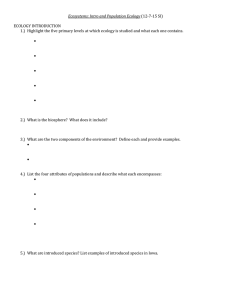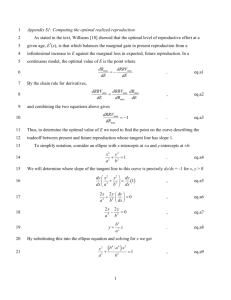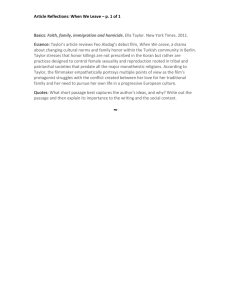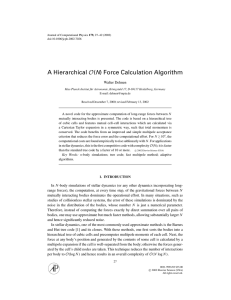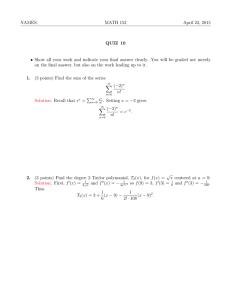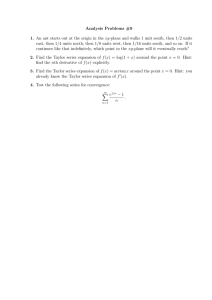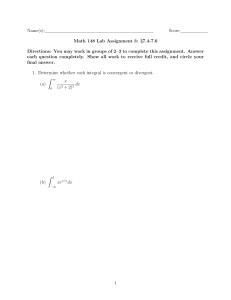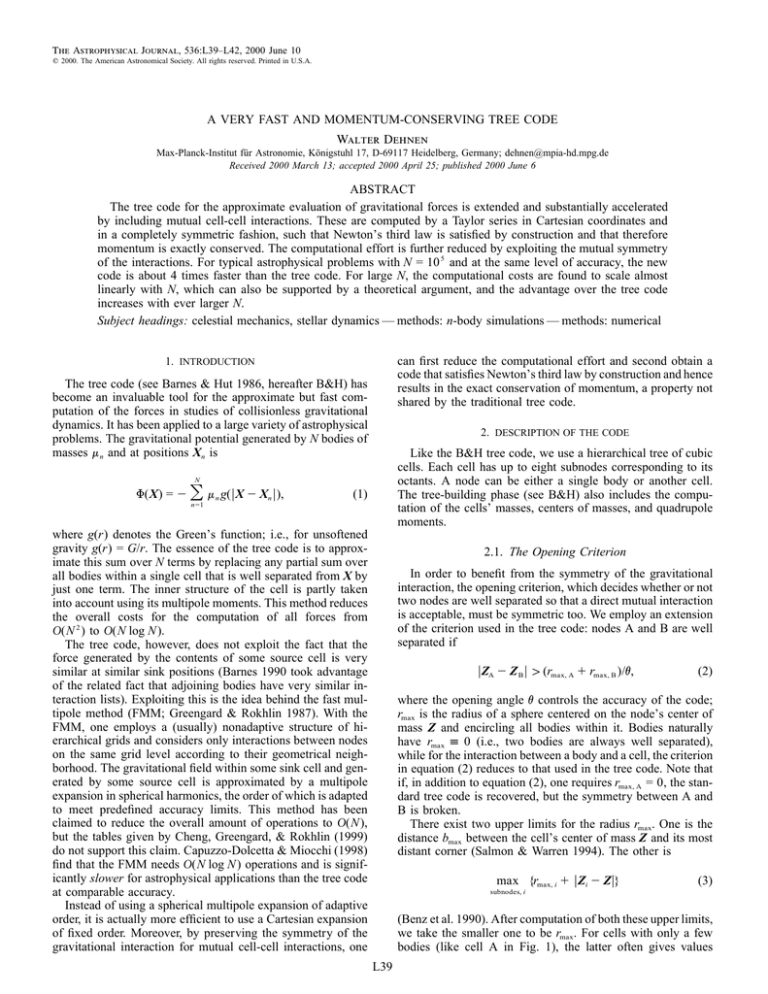
The Astrophysical Journal, 536:L39–L42, 2000 June 10
q 2000. The American Astronomical Society. All rights reserved. Printed in U.S.A.
A VERY FAST AND MOMENTUM-CONSERVING TREE CODE
Walter Dehnen
Max-Planck-Institut für Astronomie, Königstuhl 17, D-69117 Heidelberg, Germany; dehnen@mpia-hd.mpg.de
Received 2000 March 13; accepted 2000 April 25; published 2000 June 6
ABSTRACT
The tree code for the approximate evaluation of gravitational forces is extended and substantially accelerated
by including mutual cell-cell interactions. These are computed by a Taylor series in Cartesian coordinates and
in a completely symmetric fashion, such that Newton’s third law is satisfied by construction and that therefore
momentum is exactly conserved. The computational effort is further reduced by exploiting the mutual symmetry
of the interactions. For typical astrophysical problems with N = 10 5 and at the same level of accuracy, the new
code is about 4 times faster than the tree code. For large N, the computational costs are found to scale almost
linearly with N, which can also be supported by a theoretical argument, and the advantage over the tree code
increases with ever larger N.
Subject headings: celestial mechanics, stellar dynamics — methods: n-body simulations — methods: numerical
can first reduce the computational effort and second obtain a
code that satisfies Newton’s third law by construction and hence
results in the exact conservation of momentum, a property not
shared by the traditional tree code.
1. INTRODUCTION
The tree code (see Barnes & Hut 1986, hereafter B&H) has
become an invaluable tool for the approximate but fast computation of the forces in studies of collisionless gravitational
dynamics. It has been applied to a large variety of astrophysical
problems. The gravitational potential generated by N bodies of
masses m n and at positions Xn is
O
2. DESCRIPTION OF THE CODE
Like the B&H tree code, we use a hierarchical tree of cubic
cells. Each cell has up to eight subnodes corresponding to its
octants. A node can be either a single body or another cell.
The tree-building phase (see B&H) also includes the computation of the cells’ masses, centers of masses, and quadrupole
moments.
N
F(X) = 2
m n g(FX 2 XnF),
(1)
n=1
where g(r) denotes the Green’s function; i.e., for unsoftened
gravity g(r) = G/r. The essence of the tree code is to approximate this sum over N terms by replacing any partial sum over
all bodies within a single cell that is well separated from X by
just one term. The inner structure of the cell is partly taken
into account using its multipole moments. This method reduces
the overall costs for the computation of all forces from
O(N 2 ) to O(N log N).
The tree code, however, does not exploit the fact that the
force generated by the contents of some source cell is very
similar at similar sink positions (Barnes 1990 took advantage
of the related fact that adjoining bodies have very similar interaction lists). Exploiting this is the idea behind the fast multipole method (FMM; Greengard & Rokhlin 1987). With the
FMM, one employs a (usually) nonadaptive structure of hierarchical grids and considers only interactions between nodes
on the same grid level according to their geometrical neighborhood. The gravitational field within some sink cell and generated by some source cell is approximated by a multipole
expansion in spherical harmonics, the order of which is adapted
to meet predefined accuracy limits. This method has been
claimed to reduce the overall amount of operations to O(N),
but the tables given by Cheng, Greengard, & Rokhlin (1999)
do not support this claim. Capuzzo-Dolcetta & Miocchi (1998)
find that the FMM needs O(N log N) operations and is significantly slower for astrophysical applications than the tree code
at comparable accuracy.
Instead of using a spherical multipole expansion of adaptive
order, it is actually more efficient to use a Cartesian expansion
of fixed order. Moreover, by preserving the symmetry of the
gravitational interaction for mutual cell-cell interactions, one
2.1. The Opening Criterion
In order to benefit from the symmetry of the gravitational
interaction, the opening criterion, which decides whether or not
two nodes are well separated so that a direct mutual interaction
is acceptable, must be symmetric too. We employ an extension
of the criterion used in the tree code: nodes A and B are well
separated if
FZA 2 Z BF 1 (rmax, A 1 rmax, B )/v,
(2)
where the opening angle v controls the accuracy of the code;
rmax is the radius of a sphere centered on the node’s center of
mass Z and encircling all bodies within it. Bodies naturally
have rmax { 0 (i.e., two bodies are always well separated),
while for the interaction between a body and a cell, the criterion
in equation (2) reduces to that used in the tree code. Note that
if, in addition to equation (2), one requires rmax, A = 0 , the standard tree code is recovered, but the symmetry between A and
B is broken.
There exist two upper limits for the radius rmax. One is the
distance bmax between the cell’s center of mass Z and its most
distant corner (Salmon & Warren 1994). The other is
max {rmax, i 1 FZi 2 ZF}
(3)
subnodes, i
(Benz et al. 1990). After computation of both these upper limits,
we take the smaller one to be rmax. For cells with only a few
bodies (like cell A in Fig. 1), the latter often gives values
L39
L40
VERY FAST, MOMENTUM-CONSERVING TREE CODE
Vol. 536
significantly smaller than bmax , while for cells with many bodies
(like cell B in Fig. 1), bmax is the tighter limit.
2.2. Approximating Gravity
Consider two bodies at X and Y that reside in two wellseparated cells A and B with centers of mass at, respectively,
ZA and Z B and separation R { ZA 2 Z B. We may rewrite
X 2 Y = R 1 (x 2 y), with x { X 2 ZA and y { Y 2 Z B being
small in magnitude compared with R (because the cells are
well separated; see Fig. 1). The Taylor expansion of g(FX 2
YF) around R reads
g(FX 2 YF) =
O
p
1
{[(x 2 y) · =] pg(FrF)}r=R .
p!
(4)
Fig. 1.—Two well-separated cells. The solid and dotted circles have radii
rmax and rmax/v, respectively.
Separating powers of x from powers of y in equation (4) and
subsequently taking the mass-weighted sum over cell B yields
a Cartesian multipole expansion of the potential FBrA(X) at
any position X within cell A and generated by all bodies inside
cell B (Warren & Salmon 1995). Since Z B was chosen to be
the center of mass of cell B, its dipole vanishes. The highest
order multipole occurring in such an expansion may actually
be omitted since it only contributes a constant to the approximation for g and does not affect the approximation for =g
(and hence the force). The expression of third order thus reads
(without the octopole and using Einstein’s sum convention)
U
˜ D (2) 1 x (D (1) 1 Q
˜ D (3) )
FBrA(X) ≈ MB D(0) 1 12 Q
B, ij
ij
i
i
B, jk
ijk
1
I
1
1
(3)
x x D (2) 1 xi xj xkDijk
,
2 i j ij
6
(5)
˜ are the mass and specific quadrupole moment
where MB and Q
B
Q̃B, ij {
O
1
m y y
MB yn1ZBPcell B n ni nj
(6)
of cell B, while D (n) { = ng(r)Fr=FRF; i.e.,
D (0) = D 0,
(1)
i
D
(7a)
1
= Ri D ,
(7b)
Dij(2) = dij D 1 1 R i Rj D 2,
(3)
ijk
D
(7c)
= (dij Rk 1 djk R i 1 dki Rj )D 1 R i Rj Rk D ,
2
3
(7d)
with
F(1r ­r­ ) g(r)F
The transformation, or shifting, of the expansion center to
some other position is trivial compared with the analogous
procedure in the FMM (see Cheng et al. 1999).
2.3. The Algorithm
The standard tree code computes the forces on each body
by a recursive tree walk, which visits each node exactly once
as a gravity sink, and thus exhibits an inherent asymmetry
between sources and sinks. The new algorithm avoids this
asymmetry.
First, in the interaction phase, the Taylor series coefficients
are evaluated and accumulated in data fields associated with
each node. This phase is based on the concept of mutual interactions (MIs), pairs of nodes, A and B, such that bodies in
node A must receive forces from all bodies in node B and vice
versa. We start by the MI describing the root-root self-interaction, and we process a given MI as follows: a body selfinteraction is ignored; (2) a cell self-interaction is split into the
MIs between the subnodes,1 and the process is continued on
each of the new MIs; (3) an MI representing a well-separated
pair of nodes is executed: the Taylor coefficients are computed
and added to the nodes’ corresponding data fields; and (4)
finally, in any other case, the node with larger rmax is split, and
up to eight new MIs are created and processed.
Second, in the collection phase, the Taylor coefficients are
passed down the tree, the expansion center is shifted to the
currently active cell, and adding to its coefficients. The Taylor
expansion is evaluated at the position of any body, and the
values for potential and acceleration are added to its data fields
(which may already contain contributions accumulated during
the interaction phase).
3. PERFORMANCE TESTS
n
Dn {
.
(8)
r=FRF
The symmetry between x and y at every order of the Taylor
expansion in equation (4) has two important consequences.
First, if this expansion is used to compute both FBrA(X) and
FArB (Y), Newton’s third law is satisfied by construction. Note
that our omission of the octopole term broke the symmetry
only in the zeroth order and has no effect on the forces.
Second, the expressions for MAFBrA and MBFArB are very
similar: the expansion coefficients of second and third order
differ only by mere signs, such that computing these coefficients for both Taylor series at one time is substantially faster
than computing them at different times.
We tested the new algorithm and compared it with the tree
code in three typical astrophysical situations: (1) a spherical
Plummer model, representing a rather homogeneous stellar system, (2) a spherical Hernquist (1990) model galaxy, and (3) a
group of five such galaxies with various masses and scale radii.
We generated 105 random initial positions from each of these
cases, truncating the density at 1000 scale radii, and evaluated
the exact mutual forces at all positions and the approximated
forces due to the tree code (up to quadrupole order) and the
new code for opening angles v between 0.2 and 1. We used
an optimally chosen softening with the biweight softening ker1
In a cubic oct-tree, these are at most 36 independent sub-MIs.
No. 1, 2000
DEHNEN
L41
Fig. 2.—CPU time consumption plotted vs. the mean and 99% relative force error for the three test cases. The symbols correspond, from left to right, to v =
0.2, 0.3, 0. 4, 0.5, 0.6, 0.7, 0.8, 0.9, and 1.
nel (see Dehnen 2000), but the results are insensitive to these
settings. Both approximate methods have been coded by the
author2
and
use
the
same
opening
criterion
(§ 2.1). In order to measure the accuracy of the approximated
forces, we evaluated (Capuzzo-Dolcetta & Miocchi 1998)
e n = Fan 2 anPPFZanPP,
(9)
where an denotes the magnitude of the acceleration of the nth
body due to either of the approximate methods and anPP denotes
the magnitude of the exact computation.
Figure 2 plots the CPU time needed for the force approximation on a Pentium III/500 MHz PC versus the mean relative
error and that at the 99th percentile. For the new code, the time
consumption scales almost inversely with the error, while the
tree code flattens off3 at v * 0.7. Evidently, at an acceptable
level of accuracy, e.g., e 99% = 0.01, the new code is about 4
times faster than the tree code, even though it requires a smaller
value of v (0.5 as compared with 0.7 for the tree code).
For the test case of the Hernquist model, Figure 3 plots the
CPU time consumption per body versus N at fixed v = 0.7 for
the tree code and 0.5 for the new code. The tree code shows
the well-known log N scaling, while for N * 10 5 the new code
requires only a constant amount of CPU time per body. This
can be explained as follows. Arranging eight root cells to a
new root box increases N to 8N and the number NI of interactions to 8(NI 1 N1 ), where 8N1 interactions are needed to
compute the forces between the former root cells. Thus,
dNI NI D log NI NI 1 N1 / ln 8
.
=
.
dN
N D log N
N
tion (10) yields
NI ∝ N 2 c 1 N 2/3 2 c 2 ,
(11)
with constants c 1 and c 2 that depend on v. Thus, at large N, a
linear relation is approached. Note that this argument differs
from that given for the FMM by Greengard & Rokhlin (1987),
who assumed that the resolution may remain fixed when increasing N.
4. DISCUSSION
A new code for the approximate evaluation of gravitational
forces has been presented, tested, and compared with the tree
code. This new code is substantially faster than the tree code.
Moreover, unlike the latter, it satisfies Newton’s third law by
construction, such that any N-body code based on it will not
introduce spurious net accelerations. The new code is based on
a Taylor expansion of the Green’s function in Cartesian coordinates and incorporates mutual cell-cell interactions. The
simple algorithm is well suited for implementation on parallel
computers: different MIs can be passed to different CPUs.
The scaling of the CPU time required for the mutual forces
of a number N of bodies becomes essentially linear at
(10)
In the tree code, N1 ∝ N, yielding NI ∝ N log N. In the new
code, N1 may be estimated to contain two contributions, a
constant term that accounts for the interactions with distant
nodes and a term that is proportional to N 2/3 for those on
the surface of the former root cells. Inserting this into equa2
At the same v, the tree code is twice as fast as a code publicly available
from J. Barnes, mainly because the new opening criterion leads to fewer
interactions. However, even at the same number of interactions, the author’s
code was about 30% faster.
3
This is because rmax is not proportional to the cell size, so that increasing
v from 0.7 does not decrease the number of interactions by much.
Fig. 3.—CPU time per body plotted vs. N for test case 2 (Hernquist model)
L42
VERY FAST, MOMENTUM-CONSERVING TREE CODE
N * 10 5, so that with ever larger N the new code is increasingly
faster than the tree code, allowing for a substantial improvement
in simulations employing large number of bodies. The only
disadvantage is the increased requirement of memory compared
with the standard tree code: 20 floating point numbers per cell
are needed to hold the Taylor expansion coefficients. (By using
a tree-walking algorithm instead of that given in § 2.3, one can
avoid this at the price of enhanced CPU time consumption.)
In spirit, the new code is similar to Greengard & Rokhlin’s
(1987) fast multipole method, but it is more efficient because
it uses a Cartesian instead of a spherical-harmonic multipole
expansion and fixes the order of the expansion, while controlling the accuracy via the interaction condition rather than
Vol. 536
fixing the interactions and adapting the expansion order to the
accuracy.
One concern that one may have with codes that are based
on cell-cell interactions is their performance in the presence of
individual time steps. Clearly, when not all the forces are to
be computed, such codes fare less favorably. However, when
the forces for all bodies within some domain are desired, the
new code is still a significant improvement over the tree code.
The new code has been written in C11 and is electronically
available from the author upon request.
The author thanks Tom Quinn for valuable discussions and
Joshua Barnes, Lars Hernquist, Junichiro Makino, Andy Nelson, and Thorsten Naab for useful comments.
REFERENCES
Barnes, J. E. 1990, J. Comput. Phys., 87, 161
Barnes, J. E., & Hut, P. 1986, Nature, 324, 446 (B&H)
Benz, W., Bowers, R. L., Cameron, A. G. W., & Press, W. H. 1990, ApJ, 348,
647
Capuzzo-Dolcetta, R., & Miocchi, P. 1998, J. Comput. Phys., 143, 29
Cheng, H., Greengard, L., & Rokhlin, V. 1999, J. Comput. Phys., 155, 468
Dehnen, W. 2000, MNRAS, submitted
Greengard, L., & Rokhlin, V. 1987, J. Comput. Phys., 73, 325
Hernquist, L. 1990, ApJ, 356, 359
Salmon, J. K., & Warren, M. S. 1994, J. Comput. Phys., 111, 136
Warren, M. S., & Salmon, J. K. 1995, Comput. Phys. Commun., 87, 266

